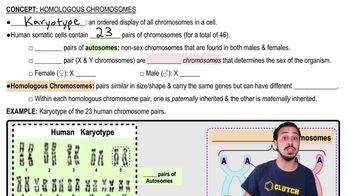Textbook Question
Cell A has half as much DNA as cells B, C, and D in a mitotically active tissue. Cell A is most likely in
a. G1
b. G2
c. Prophase
d. Metaphase
3050
views

 Verified step by step guidance
Verified step by step guidance



Cell A has half as much DNA as cells B, C, and D in a mitotically active tissue. Cell A is most likely in
a. G1
b. G2
c. Prophase
d. Metaphase
The drug cytochalasin B blocks the function of actin. Which of the following aspects of the animal cell cycle would be most disrupted by cytochalasin B?
a. Spindle formation
b. Spindle attachment to kinetochores
c. Cell elongation during anaphase
d. Cleavage furrow formation and cytokinesis
The light micrograph shows dividing cells near the tip of an onion root. Identify a cell in each of the following stages: prophase, prometaphase, metaphase, anaphase, and telophase. Describe the major events occurring at each stage.
<IMAGE>